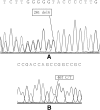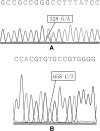A Very Rare Case with Particular H-deficient Phenotypes
- PMID: 30369771
- PMCID: PMC6186255
- DOI: 10.1007/s12288-018-0915-3
A Very Rare Case with Particular H-deficient Phenotypes
Abstract
Bombay phenotype, H partially deficient non secretor phenotype and Para-Bombay phenotype are rare blood groups with deficiency or absence of H antigen. A 52-year-old female with Chronic suppurative otitis media was referred to our hospital. The primary serologic results of ABO blood typing were discrepant in forward and reverse grouping. Further, the saliva secretion tests, the pedigree studies and the sequence analysis were performed to confirm the rare phenotype. The patient was diagnosed as a variant H-deficient phenotype, secretor (para-bombay). Red cells of the patient have no H antigens, and it's a very interesting thing that there were two opposite results in the saliva test by using different anti-H. The test showed that H substances were present in the saliva by using anti-H from Libo Biotechnology Co, while which were absent by using anti-H from Shanghai blood center. The patient's Lewis phenotype was Le (a-b+). Anti-HI was present in the sera of her. The sequence of the ABO gene of the patient was 261delG and 467C>T heterozygote by direct DNA sequencing and was assigned as A102/O01. There were two mutations of the patient's FUT1, 328G/A and 658C/T, which were identified by DNA sequencing compared with the reference sequence (GenBank, NG_007510.2). In this case, we report a patient with particular H-deficient phenotype, secretor, which showed opposite results in the saliva test by using anti-H from different sources. We suspect that it is a variant of para-Bombay phenotype.
Keywords: Blood group; H-deficient phenotypes; Red cell.
Conflict of interest statement
The authors declare that they have no conflict of interest.All procedures performed in studies involving human participants were in accordance with the ethical standards of the institutional and/or national research committee and with the 1964 Helsinki declaration and its later amendments or comparable ethical standards.
Figures
Similar articles
-
Blood group discrepancy in Ah para-Bombay phenotype: a rare blood group variant and its clinical significance.Immunohematology. 2021;37(4):160-164. doi: 10.21307/immunohematology-2021-026. Immunohematology. 2021. PMID: 34964314
-
Neonatal testing leading to the identification of Bh (para-Bombay) phenotype in the mother: case report with review of the literature.Immunohematology. 2021 Jun;37(2):59-63. doi: 10.21307/immunohematology-2021-008. Immunohematology. 2021. PMID: 34170641 Review.
-
Identification of a Case with Heterozygous Mutations in the FUT1 Gene Leading to a Para-Bombay Phenotype.Clin Lab. 2019 Dec 1;65(12). doi: 10.7754/Clin.Lab.2019.190602. Clin Lab. 2019. PMID: 31850709
-
Genotyping of the rare Para-Bombay blood group in southern Thailand.Hematol Transfus Cell Ther. 2023 Oct-Dec;45(4):449-455. doi: 10.1016/j.htct.2022.08.004. Epub 2022 Oct 9. Hematol Transfus Cell Ther. 2023. PMID: 36241527 Free PMC article.
-
[Genetic analysis of a blood donor with combined FUT1 and ABO dual blood group gene variants resulting in para-Bombay and A2 subtype blood types and a literature review].Zhonghua Yi Xue Yi Chuan Xue Za Zhi. 2024 Nov 10;41(11):1379-1386. doi: 10.3760/cma.j.cn511374-20231218-00332. Zhonghua Yi Xue Yi Chuan Xue Za Zhi. 2024. PMID: 39528290 Review. Chinese.
Cited by
-
A Pedigree Investigation of H-antigen Deletion Caused by Mutation of 658 C to T in the FUT1 Gene.Indian J Hematol Blood Transfus. 2024 Jul;40(3):504-507. doi: 10.1007/s12288-023-01669-8. Epub 2023 May 24. Indian J Hematol Blood Transfus. 2024. PMID: 39011245 Free PMC article.
References
-
- Kelly RJ, Rouquier S, Giorgi D, et al. Sequence and expression of a candidate for the human Secretor blood group alpha(1,2)fucosyltransferase gene (FUT2). Homozygosity for an enzyme-inactivating nonsense mutation commonly correlates with the non-secretor phenotype. J Biol Chem. 1995;270:4640–4649. doi: 10.1074/jbc.270.9.4640. - DOI - PubMed
-
- Rouquier S, Lowe JB, Kelly RJ, et al. Molecular cloning of a human genomic region containing the H blood group alpha(1,2)fucosyltransferase gene and two H locus-related DNA restriction fragments. Isolation of a candidate for the human Secretor blood group locus. J Biol Chem. 1995;270:4632–4639. doi: 10.1074/jbc.270.9.4632. - DOI - PubMed
-
- Daniels G. Human blood groups. 2. Malden: Blackwell Science; 2002.
-
- Geng W, Gao HH, Zhang LW. Serological characteristics and family survey of 3 cases of H-deficient blood group. Zhongguo shi yan xue ye xue za zhi. 2016;24:913–917. - PubMed
-
- Maeda H, Ohshima T, Takayasu T, Tanaka N. A case of para-Bombay phenotype Bhm (OBHm) Nihon Hoigaku Zasshi. 1985;39:209–213. - PubMed
LinkOut - more resources
Full Text Sources


